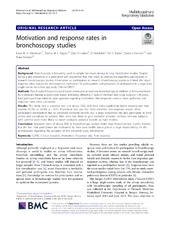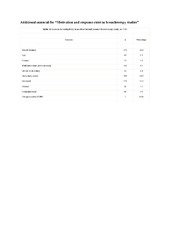| dc.contributor.author | Martinsen, Einar Marius Hjellestad | en_US |
| dc.contributor.author | Eagan, Tomas Mikal | en_US |
| dc.contributor.author | Leiten, Elise Orvedal | en_US |
| dc.contributor.author | Nordeide, Eli | en_US |
| dc.contributor.author | Bakke, Per S. | en_US |
| dc.contributor.author | Lehmann, Sverre | en_US |
| dc.contributor.author | Nielsen, Rune | en_US |
| dc.date.accessioned | 2020-05-14T11:55:18Z | |
| dc.date.available | 2020-05-14T11:55:18Z | |
| dc.date.issued | 2019-05-02 | |
| dc.Published | Martinsen EMH, Eagan TML, Leiten EO, Nordeide E, Bakke PS, Lehmann S, Nielsen R. Motivation and response rates in bronchoscopy studies. Multidisciplinary Respiratory Medicine. 2019;14:14 | eng |
| dc.identifier.issn | 2049-6958 | |
| dc.identifier.issn | 1828-695X | |
| dc.identifier.uri | https://hdl.handle.net/1956/22266 | |
| dc.description.abstract | Background Bronchoscopy is frequently used to sample the lower airways in lung microbiome studies. Despite being a safe procedure, it is associated with discomfort that may result in reservations regarding participation in research bronchoscopy studies. Information on participation in research bronchoscopy studies is limited. We report response rates, reasons for non-response, motivation for participation, and predictors of participation in a large-scale single-centre bronchoscopy study (“MicroCOPD”). Methods Two hundred forty-nine participants underwent at least one bronchoscopy in addition to being examined by a physician, having lung function tested, and being offered a CT scan of the heart and lungs (subjects > 40 years). Each participant was asked an open question regarding motivation. Non-response reasons were gathered, and response rates were calculated. Results The study had a response rate just above 50%, and men had a significantly higher response rate than women (56.5% vs. 44.8%, p = 0.01). Procedural fear was the most common non-response reason. Most participants participated due to perceived personal benefit, but a large proportion did also participate to help others and contribute to science. Men were less likely to give exclusive altruistic motives, whereas subjects with asthma were more likely to report exclusive personal benefit as main motive. Conclusion Response rates of about 50% in bronchoscopy studies make large bronchoscopy studies feasible, but the fact that participants are motivated by their own health status places a large responsibility on the investigators regarding the accuracy of the provided study information. | en_US |
| dc.language.iso | eng | eng |
| dc.publisher | Springer | eng |
| dc.rights | Attribution CC BY | eng |
| dc.rights.uri | http://creativecommons.org/licenses/by/4.0/ | eng |
| dc.title | Motivation and response rates in bronchoscopy studies | en_US |
| dc.type | Peer reviewed | |
| dc.type | Journal article | |
| dc.date.updated | 2019-12-09T13:28:18Z | |
| dc.description.version | publishedVersion | en_US |
| dc.rights.holder | Copyright 2020 The authors | |
| dc.identifier.doi | https://doi.org/10.1186/s40248-019-0178-3 | |
| dc.identifier.cristin | 1709938 | |
| dc.source.journal | Multidisciplinary Respiratory Medicine | |
| dc.identifier.citation | Multidisciplinary Respiratory Medicine. 2019, 14, 14. | |


